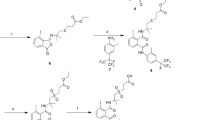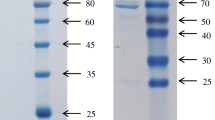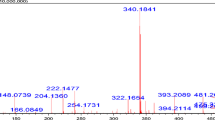Abstract
Thidiazuron (TDZ) is a synthetic plant growth regulator, which is widely used in agriculture and tissue culture. A sensitive and specific monoclonal antibody (mAb3D6F5B2) was obtained. An indirect competitive enzyme-linked immunosorbent assay (icELISA) was developed with mAb3D6F5B2. The established icELISA possessed a 50 % inhibition concentration (IC50) of 0.61 ng/mL and a quantitative range of 0.15–2.49 ng/mL. The recoveries of TDZ fortified in water and soil samples were 76–126 %. The residual level of TDZ in soil samples detected by icELISA was confirmed with high performance liquid chromatography-mass spectrometry (LC/MS). The correlation coefficient (R 2) between the two assays was 0.9898, demonstrating this icELISA is suitable to detect TDZ residues in environmental and agricultural samples.




Similar content being viewed by others
References
Arndt F et al (1976) SN 49537, a new cotton defoliant. Plant Physiol 57:99
Biesaga-Kościelniak J, Kościelniak J, Janeczko A (2010) The impact of zearalenone and thidiazuron on indirect plant regeneration of oilseed rape and wheat. Acta Physiol Plant 32:1047–1053
Cui Y, Nan T, Tan G, Li QX, Wang B, Liu S (2011) Production of monoclonal antibody to herbicide fenoxaprop-ethyl. Hybridoma 30:463–467
Cui Y, Liu K, Xu C, Liu F, Li QX, Liu S, Wang B (2014) Development of a sensitive monoclonal antibody-based indirect competitive enzyme-linked immunosorbent assay for analysing chlorantraniliprole residues. Food Chem 143:293–299
Du M-w, Ren X-m, Tian X-l, Duan L-s, Zhang M-c, Tan W-m, Li Z-h (2013) Evaluation of harvest aid chemicals for the cotton-winter wheat double cropping system. J Integr Agric 12:273–282
EPA (2005) Reregistration eligibility decision for thidiazuron. Environ Prot 4:012
Fenoll J, Hellín P, Martínez CM, Flores P, Navarro S (2012) High performance liquid chromatography–tandem mass spectrometry method for quantifying phenylurea herbicides and their main metabolites in amended and unamended soils. J Chromatogr A 1257:81–88
Ferreira M, Reinhardt C (2010) Field assessment of crop residues for allelopathic effects on both crops and weeds. Agron J 102:1593–1600
Goodrow MH, Hammock BD (1998) Hapten design for compound-selective antibodies: ELISAS for environmentally deleterious small molecules. Anal Chim Acta 376:83–91
Goodrow MH et al (1995) Strategies for immunoassay hapten design. In: Nelson J et al (ed) Immunoanalysis of agrochemicals. American Chemical Society, Washington DC, pp 119–139
He S-P et al (2009) Development of a sensitive monoclonalantibody-based enzyme-linked immunosorbent assay for the antimalaria active ingredient artemisinin in the Chinese herb Artemisia annua L. Anal Bioanal Chem 393:1297–1303
Hu J-Y, Hu Y-Q, Chen Y, Yang T (2011) High performance liquid chromatography method for residues analysis of thidiazuron in apple and soil. Bull Environ Contam Toxicol 87:448–451
Huetteman CA, Preece JE (1993) Thidiazuron: a potent cytokinin for woody plant tissue culture. Plant Cell Tissue Organ Cult 33:105–119
Kapuriya N et al (2011) Design, synthesis, and biological evaluation of novel water-soluble N-mustards as potential anticancer agents. Bioorg Med Chem 19:471–485
Karu AE, Goodrow MH, Schmidt DJ, Hammock BD, Bigelow MW (1994) Synthesis of haptens and derivation of monoclonal antibodies for immunoassay of the phenylurea herbicide diuron. J Agric Food Chem 42:301–309
Kniss AR, Lyon DJ (2011) Winter wheat response to preplant applications of aminocyclopyrachlor. Weed Technol 25:51–57
Mercader JV, Suárez-Pantaleón C, Agulló C, Abad-Somovilla A, Abad-Fuentes A (2008) Production and characterization of monoclonal antibodies specific to the strobilurin pesticide pyraclostrobin. J Agric Food Chem 56:7682–7690
Nunes GS, Toscano IA, Barceló D (1998) Analysis of pesticides in food and environmental samples by enzyme-linked immunosorbent assays. TrAC Trends Anal Chem 17:79–87
Pavlista AD, Gall C (2011) Delaying early blight onset in potato with thidiazuron. Am J Potato Res 88:114–120
Snipes C, Wills G (1994) Influence of temperature and adjuvants on thidiazuron activity in cotton leaves. Weed Sci 42:13–17
Stan H-J, Klaffenbach P (1991) Determination of carbamate pesticides and some urea pesticides after derivatization with acetic anhydride by means of GC-MSD. Fresenius’ J Anal Chem 339:151–157
Suárez-Pantaleón C, Mercader JV, Agullo C, Abad-Somovilla A, Abad-Fuentes A (2010) Hapten synthesis and polyclonal antibody-based immunoassay development for the analysis of forchlorfenuron in kiwifruit. J Agric Food Chem 58:8502–8511
Suttle JC (1985) Involvement of ethylene in the action of the cotton defoliant thidiazuron. Plant Physiol 78:272–276
Thomas NR (1994) Hapten design for the generation of catalytic antibodies. Appl Biochem Biotechnol 47:345–372
Yip W-K, Yang SF (1986) Effect of thidiazuron, a cytokinin-active urea derivative, in cytokinin-dependent ethylene production systems. Plant Physiol 80:515–519
Zhao J et al (2006a) Development of a monoclonal antibody-based enzyme-linked immunosorbent assay for the analysis of glycyrrhizic acid. Anal Bioanal Chem 386:1735–1740
Zhao J et al (2006b) Development of a monoclonal antibody-based enzyme-linked immunosorbent assay for the herbicide chlorimuron-ethyl. J Agric Food Chem 54:4948–4953
Acknowledgments
The authors would like to thank Dr. Mingwei Du, College of Agriculture and Biotechnology, China Agricultural University, for providing soil samples.
Author information
Authors and Affiliations
Corresponding authors
Rights and permissions
About this article
Cite this article
Cui, Y., Cao, Z., Guo, S. et al. Hapten Synthesis and Monoclonal Antibody-Based Immunoassay Development for the Analysis of Thidiazuron. J Plant Growth Regul 35, 357–365 (2016). https://doi.org/10.1007/s00344-015-9537-2
Received:
Accepted:
Published:
Issue Date:
DOI: https://doi.org/10.1007/s00344-015-9537-2




